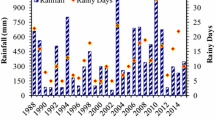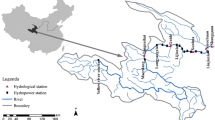Abstract
Knowing the rate of evaporation from surface water resources such as channels and reservoirs is essential for precise management of the water balance. Few detailed evaporation studies exist for small lakes or reservoirs in arid regions of the world. In this study, monthly evaporation was determined by Bowen Ratio Energy Budget technique (BREB) for Alghadir reservoir (Saveh, Iran) from 1995–2007 and compared with class-A pan. Daily data were obtained from IMO (Iran Meteorological Organization) weather station, located near the reservoir, for all of these years. Some variations have been observed on the estimated evaporation of the energy budget at different years, ranging from 151 cm for 1997 to 174 cm for 2006. There is no specific evaporation pattern for all the years, but evaporation rates were low in winter (January and February) and highest during the summer (July and August). However, the times and month of highest evaporation rates varied during the study period. Surveying of reservoir thermal structure showed that, inflow and outflow energy fluxes to this water volume have large variations. In addition, incoming solar shortwave radiation, incoming atmospheric longwave radiation, and longwave atmospheric radiation emitted from the water surface are largest energy fluxes for this small and deep reservoir. Results of this study could explain the importance and sensible contribution of the evaporation rates as a fundamental parameter in the hydrological cycle of reservoirs ecosystem in the arid regions of Iran.
Similar content being viewed by others
References
Singh, V.P. and Xu, C.Y., Evaluation and generalization of 13 mass-transfer equations for determining free water evaporation, Hydrol. Process., 1997, vol. 11, pp. 311–323.
Rosenberry, D.O., Winter, T.C., Buso, D.C., and Likens, G.E., Comparison of 15 evaporation methods applied to a small mountain lake in the northeastern USA, J. Hydrol., 2007, vol. 340, pp. 149–166.
Oroud, I.M., Effects of salinity upon evaporation from pans and shallow lakes near the Dead Sea, Theor. Appl. Climatol., 1995, vol. 52, pp. 231–240.
Drexler, J.Z., Snyder, R.L., Spano, D., and Kyaw, T., A review of models and micrometeorological methods used to estimate wetland evapotranspiration, Hydrol. Process., 2004, vol. 18, pp. 2071–2101.
Henderson-Sellers, B., Calculating the surface energy balance for lake and reservoir modeling: a review, Rev. Geophys., 1986, vol. 24, no. 3, pp. 625–649.
Schindler, D.W., The cumulative effects of climate warming and other human stresses on Canadian freshwaters in the new millennium, Can. J. Fish. Aquat. Sci., 2001, vol. 58, no. 1, pp. 18–29.
Bowie, G., Mills, W., Porcella, D., et al., Rates, constants and kinetics formulations in surface water quality modeling, EPA/600/3-85/040, Athens, USA, 1985.
Dos Reis, R. and Dias, N., Multi-season lake evaporation: energy-budget estimates and CRLE model assessment with limited meteorological observations, J. Hydrol., 1998, vol. 208, pp. 135–147.
Winter, T., Buso, D., Rosenberry, D., et al., Evaporation determined by the energy-budget method for Mirror Lake, New Hampshire, Limnol. Oceanogr., 2003, vol. 48, no. 3, pp. 995–1009.
Orlob, G., Models for Water Quality Management, USA: McGraw Hill, 1981, pp. 273–313.
Jensen, M.E., Burman, R.D., and Allen, R.G., Evapotranspiration and irrigation water requirements, Amer. Soc. of Civil Eng., N.Y., 1990.
Allen, R., Pereira, L., Raes, D., and Smith, M., Crop evapotranspiration: guidelines for computing crop water requirements, FAO Irrigation and Drainage Paper, Rome: FAO, 1998, vol. 56, p. 300.
Kamali, G. and Moradi, A., Solar radiation: basics and applications in the agriculture and novel energies, Meteor. Res. Center Publ., 2004.
Kotsopoulos, S. and Babajimopoulos, C., Analytical estimation of modified Penman equation parameters, J. Irrig. Drain. Eng., 1997, vol. 123, no. 4, pp. 253–256.
Henderson-Sellers, B., Calculating the surface energy balance for lake and reservoir modeling: a review, Rev. Geophys., 1986, vol. 24, no. 3, pp. 625–649.
Anderson, E.R., Energy-budget studies, water-loss investigations: Lake Hefner studies, US Geol. Surv. Prof. Pap., 1954, vol. 269, pp. 71–119.
Winter, T.C., Uncertainties in estimating the water balance of lakes, Water Resour. Bull., 1981, vol. 17, pp. 82–115.
Author information
Authors and Affiliations
Corresponding author
Additional information
The article is published in the original.
Rights and permissions
About this article
Cite this article
Hassani, A. Thermal structure and Energy Budget for Alghadir reservoir, Iran. Water Resour 40, 621–630 (2013). https://doi.org/10.1134/S0097807813060134
Received:
Published:
Issue Date:
DOI: https://doi.org/10.1134/S0097807813060134




